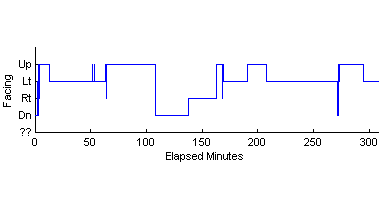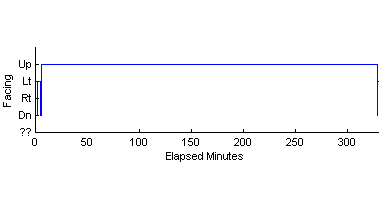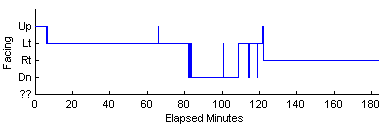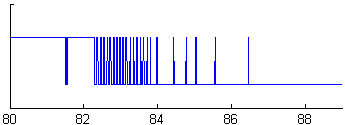

|
Order AcuSleep for your child |

 Gallery of Body Positions
Gallery of Body Positions
This page shows examples of body position measurements made by the AcuSleep system.
Introduction
The AcuSleep test measures body position continuously during a test. It assumes the subject is always lying down. At any instant the subject's position is classified as one of:The Position Diagram
- Up -- Subject is facing up, lying on his or her back,
- Lt -- Subject is facing left, lying on his or her left side,
- Rt -- Subject is facing right, lying on his or her right side,
- Dn -- Subject is facing down, lying on his or her front.
- ?? -- Subject's body position is unknown. This is rare.
The figure below shows a normal 10 year old boy's body position during the 300+ minutes the AcuSleep system recorded data.Case 1: Near immobilityNotice:
- Changes in position are frequent.
- There is rapid change in body position in the first few minutes.
- The subject spent time in each of the major body positions.
- The body position in which the subject probably fell asleep (facing up) does not predict the most common body position during the rest of the night (on left side).
This is a 70 year old woman with very painful bursitis of both shoulders. Moving in bed causes severe discomfort. It is no surprise, therefore, that she spends essentially the entire night in one body position (facing up).Case 2: Rapid "changes" in body position
Some studies will show periods of rapid changes between two body positions. For example, in the position diagram below, the thickness of the line just after minute 80 is a clue that several position shifts have occurred.A magnified view of minutes 80 to 89 confirms multiple rapid changes between two positions: Such rapid shifts may signify: In this case, the subject had assumed a position near the borderline of two positions and small movements related to normal breathing were enough to change the position reading.
- Rapid movement between the positions -- Example: the subject is rocking. This, however, is not as common as the next two possibilites;
- A body position near the borderline of two positions;
- An upright position, possibly walking or standing.

 Nothing herein should be construed as medical advice. Terms and Conditions. Privacy.
Nothing herein should be construed as medical advice. Terms and Conditions. Privacy.
Copyright (C) 2002-2005 by Apneos Corporation. All Rights Reserved. Patents pending.
v.DHF-T



